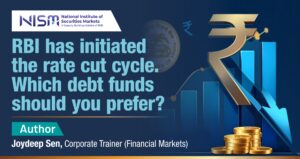
Mark-to-market gains should not be the only objective for investing in debt funds
For quite some time, market has been expecting rate cut(s) from the RBI. Based on this expectation, the recommendation has been for longer duration funds. The rationale is, given that interest rate and bond price move inversely, longer the duration of the fund, higher will be the gains. On 7 February 2025, the Reserve Bank of India (RBI) initiated the rate cut cycle. The repo rate, which is the signal for interest rates across the system, was reduced by 25 basis points from 6.5 percent to 6.25 percent. Now it is time to take stock.
View going forward
The expectation going forward is that the RBI would execute another 25 basis point cut, or at most two more cuts of 25 basis points each, at an appropriate time. This cycle is going to be a shallow rate cut cycle, as they have to take care of inflation as well. Markets, however, react in anticipation. The 10-year government bond yield eased from 7.2 percent on 1 January 2024 to 6.75 percent on 6 February 2025, even before any rate cut. As and when market starts anticipating the next rate cut, yield level on bonds would ease further. That is, there is further scope for gaining from interest rates coming down. However, it has to seen in context.
How debt funds work
Returns of debt funds come from two avenues. Bonds and other instruments in debt funds have coupon or interest, which is accounted for in every day’s net asset value (NAV) on a proportionate basis. This component of returns from debt funds, which is known as accrual as it accrues gradually every day, happens any which way, irrespective of market movements. The other part is mark-to-market gains or losses. The daily NAV is computed, taking that day’s bond prices into account. When interest rates come down (bond prices move up), it adds to accrual returns. When interest rates move up (bond prices come down) it takes away from accrual returns.
When there is a rally in the market i.e. bond yields are coming down, bond prices are moving up and adding to your returns, accrual levels for the subsequent period is coming down. Let us take an illustration. Year one, the yield-to-maturity of the fund is 8 percent and recurring expense is 1 percent. Hence the net accrual level is 7 percent. To be noted, this 7 percent is not a given, not a commitment from the Mutual Fund, but an illustration for understanding. If yield level in the market does not move, over one year, you will get approx. Rs 7 per Rs 100 of investment. Now let us say there is a rally in the market of 50 basis points (0.5 percent). The addition to accrual due to yield coming down is a function of the modified duration of the fund, which is a data point available in the monthly fact sheet.
If the portfolio maturity of the fund is say 9 years and modified duration is say 5 years, then the mark-to-market addition is 0.5 percent X 5 = 2.5. Your overall return is 7+2.5 = Rs 9.5 per Rs 100. If the portfolio maturity of the fund is 3 years and modified duration is 2.5 years, then the mark-to-market addition is 0.5 percent X 2.5 = 1.25. Your overall return is 7+1.25 = Rs 8.25 per Rs 100.
The point is, after the rally of year one, for the second year, your accrual level is 6.5 percent, down from 7 percent. Unless there is further rally in year two, your returns will be approx. 6.5 percent. If your approach is to benefit from the rally and move out i.e. you want to take 9.5 percent and exit, then you have to be clear in your mind. Post exit from the debt fund, where you would move to e.g. equity fund / any other category, and what is the rationale for the move. Your portfolio should not be managed on the basis of jumping from one asset class to another, but a judicious allocation as per your objectives.
Recommended approach
One defining aspect of debt funds is that there is a correspondence between fund portfolio maturity, volatility and ideal investment horizon. While volatility i.e. yield levels moving up or down will be there, the accrual will take care of it. The impact of volatility on the fund returns will be proportionate to the modified duration, which is a function of portfolio maturity of the fund. Longer the maturity and duration, higher the impact, and vice versa. As a ballpark guidance, it is recommended that you match your investment horizon with the portfolio maturity. When there is adverse volatility i.e. yield levels move up, the accrual over that period of time (your holding period) will take care of it.
In the earlier examples, when you get say 9.5 percent or 8.25 percent in year one and 6.5 percent in year two, over the investment horizon, it averages out. Your annualized return would be somewhere around the return which initially you would have realistically expected, not just looking at the benefit of the rally.
SEBI has defined 16 debt fund categories, and there is some extent of uniformity in the Mutual Fund industry on the portfolio maturity in a given category. As an example, Gilt Funds (government bond funds) would be run with a long portfolio maturity and portfolio duration. Corporate Bond Funds would have a portfolio maturity of say 4 – 5 years, and Short Duration Funds around 3 years. The data on portfolio maturity and duration is available on the monthly factsheet, which is published on the website of Mutual Funds.
Conclusion
If you want to benefit from the remaining part of the rally e.g. 10-year government bond yield moving to say 6.5 percent, you can play it through Gilt Funds, which usually have long duration. Towards the end of the rally, if you do not have the requisite long investment horizon, you can move to a relatively shorter maturity / duration fund. To be noted, this has a tax implication. Capital gains are taxable as short term capital gains at your marginal tax slab, irrespective of your holding period. Dividends (now known as income distribution cum capital withdrawal) also are taxable at your marginal slab rate. You have to take your decision, keeping in mind the expected returns from the fund, and tax implication.
Author: Joydeep Sen, Corporate Trainer (Financial Markets)
Originally publish in Outlook Money on 19 th March, 2025
https://www.outlookmoney.com/invest/how-rbis-rate-cut-affects-debt-funds

SIP and EMI: three-letter synonyms, but diametrically opposite You are king of your money or slave to your expenses SIP…

Watching the finals of the ICC Women’s World Cup Final, where the Indian Women’s Cricket Team defeated the South African…

In the complex architecture of India’s financial system, very few institutions have had as profound and far-reaching an impact as…
© 2025 National Institute of Securities Markets (NISM). All rights reserved.